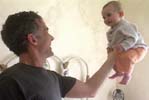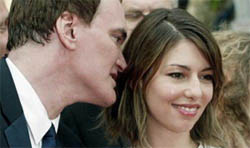The Gothamist Life Aquatic contest is over, and Congratulations! Everyone’s a winner. A few people won more than the rest, obviously. And G-mist and Cinecultist’s Karen–whose brainchild this publicity coup was–got the big prize, a phone interview with director Wes Anderson himself.
Eerily enough, it sounds like he’s right there with her at Lucky Strike.
Karen came to last night’s Reel Roundtable screening of After Life [thanks, Elizabeth!], by the way; and on Jan. 17, she’s starring in a Reel Roundtable screening of Kieron Walsh’s When Brendan Met Trudy, so clear your calendars.
Today is Wes Anderson Day! [cinecultist]
Wes Anderson: he knows where you are [Gothamist]
Reel Roundtable’s Film & Blogs Series [reelroundtable.com]
Category: interviews
In case the last post wasn’t long enough for you…
Gothamist has an excellent interview with Errol Morris about his Switch ads featuring former Bush voters who are now voting for Kerry. Morris talks at length about The Fog of War and its relevance today, his interviewing techniques, and how we’re doomed to repeat the past–the only difference is whether we do it with irony or not.
Errol Morris: The Gothamist Interview, as time closes in
Errol Morris: see his ever-expanding Ex-Bush Voters For Kerry Ad Campaign
Errol Morris: The greg.org Interview, just before the Oscar.
In case the last post wasn’t long enough for you…
Gothamist has an excellent interview with Errol Morris about his Switch ads featuring former Bush voters who are now voting for Kerry. Morris talks at length about The Fog of War and its relevance today, his interviewing techniques, and how we’re doomed to repeat the past–the only difference is whether we do it with irony or not.
Errol Morris: The Gothamist Interview, as time closes in
Errol Morris: see his ever-expanding Ex-Bush Voters For Kerry Ad Campaign
Errol Morris: The greg.org Interview, just before the Oscar.
I [Heart] Huckstering
My boy David O. Russell may be shooting negative karma beams at the back of Sharon Waxman’s head, but that’s not stopping him from spelling “P&A” with a capital “N-Y-T.”
It feels like those multimedia interstitials for I [Heart] Huckabee’s have been running for weeks now (Seriously, what’s the buy on those things? If it’s entirely clickthrough-based, they’ll have to start pushing the DVD before too much longer.) And if People Who Don’t Skip This Ad wasn’t niche enough, Fox Searchlight is pitching the film at the even smaller People Who Actually Opt In For Ad Mail market.
Here’s the kicker: This morning’s I[H]H spam was a plaintive 1,000-word Story of My Life And My Movie by the director himself. And I mean himself. No copy editors were harmed or even inconvenienced in the making of this email, which Gawker helpfully published this afternoon.
And which I’ve happily pasted in its spamalicious entirety after the jump. Now if you copy it and forward it to all your friends, not only will you help save the life of a little girl with cancer–who’s been kidnapped–but Bill Gates will take you on a trip to Disneyland. Which has to be good for your karma.
greg.org, heck yeah!
Wingnuts on both ends of the political spectrum, it’s not about you. So take a chill pill, throw another fat Costco steak on the grill, and read Matt Stone & Trey Parker’s interview with Heather Havrilesky in Salon. I so called it.
Embittered filmmakers, meanwhile, should read it to find out how the script went from South Park 2 comedy to Dr. Strangelove play-it-straight satire, before becoming the scintillating assfest you see before you.
“it’s not just us, and the fact that we live in this L.A. bubble” [salon]
Listen to these directors’ interviews
Ousmane Sembene on WNYC, of course, which I already posted
John Waters on WPS1 [although for my money, no Waters interview is better than this Oct 1998 dicussion of Pecker on Fresh Air, which makes me cry laughing to this day.]
Melvin Van Peebles from 1971, speaking at MoMA about his just-released Sweet, Sweetback’s Badassss Song.
WPS1‘s been getting its groove on lately, in case you haven’t noticed. The talk shows are tightening up a bit, and the music is rocking. Now if they can only figure out podcasting…
Exclusive: La Mexicaine Le Interview

While the discovery of an underground cinema in the center of Paris has been widely covered, little or no attention has been paid to what the films actually played there. Les Arenes de Chaillot (The Chaillot Arenas) was created by La Mexicaine de Perforation, a group of self-labeled urban explorers who, for the last five or so years, have used the invisible and forgotten infrastructure of Paris as their own curatorial venue, putting on exhibitions, concerts, and, beginning last year, film screenings.
Early Sunday morning I spoke with Lazar Kunstmann, a filmmaker, editor, and the public spokesman of LMDP about the group’s objectives, ideas, and inspirations. Turns out there were at least two weekly film series, including Urbex Movie, the one that someone narc’ed out this past summer. Here’s what they showed and why:
‘Wong Kar Wai,” Cantonese for “When it rains,”
Wong Kar Wai Week continues. Remember that “interview” with Wong Kar Wai I just linked to? Turns out it’s the Access Hollywood Movie Minute version. The HBO Original Series version–long, convoluted, emotional tumult spread out over the whole thing, lots of special guest cameos, no easy plot wrapups–is in the New York Times Magazine. Titled “The Director’s Director,” Jaime Wolf doesn’t actually work many other directors into the story. Go figure.
I only mention this because Wong’s–and his last/family name is Wong, just so you don’t embarass yourself in print or conversation–films and career have a such deep, meaningful resonance with my own.
The Director’s Director [NYT Magazine]
Nice, Short Fresh Air Interview with Richard Kelly
Richard Kelly was on Fresh Air last week to discuss the director’s cut of Donnie Darko, which is platforming out into theaters now.
Who noted that theatrical re-release is fast becoming a standard marketing element for a remastered or new-version DVD?
Listen to Richard Kelly’s interview [9/7/04, 12 min., NPR]
Buy the old DVD version on Amazon, while supplies last [“Customers also bought Requiem for a Dream, Lost in Translation, Kill Bill and Pi“? Yeah, no kidding.]
Hey, So Did I
 I first came across Jay Rosenblatt‘s short film in March, as I was surfing across the Silverdocs site, getting ready to submit my own tape.
I first came across Jay Rosenblatt‘s short film in March, as I was surfing across the Silverdocs site, getting ready to submit my own tape.
It wasn’t just the title, but the combination of title and picture. Rosenblatt was holding his daughter up in the air. The one sentence-synopsis read, “Video cameras come with an owner’s manual and babies don’t, so documentary filmmaker Jay Rosenblatt uses the first to understand the second.” The title: I Used to Be A Filmmaker.
In the first few weeks after our own kid was born, when even dubbing a couple of screeners felt like a major accomplishment, I saw my entire life in Rosenblatt’s title alone. I read some reviews (all very good) and thought, the guy spent two years on one short? I am cooked.
Actually, what Rosenblatt did was construct an interface between two worlds: his own as a documentarian and film instructor, and his new daughter’s. Or more precisely, he bridged his own two worlds, his passion/profession and his family. All in about 10 minutes. 10 minutes over the course of two years.
In I Used to be a Filmmaker, Rosenblatt uses scenes from the first 18 months of his daughter’s life to illustrate various film production terms. The still above was from “pickup shot,” for example. A scene where he gets her to stop crying is called MOS. It’s sometimes corny, but usually very funny, and it works. Rosenblatt takes some of the most unrepentantly self-indulgent imagery known to mankind–a smitten new dad’s home movies–and by giving it structure and context, makes it not just watchable by others, but actually entertaining. No small feat.
Unlike most shorts, which directors use as calling cards for the coming feature, I Used to be a Filmmaker is what it is, complete. Which made it stand out on the festival circuit enough for Shiela Nevins to buy it for Cinemax, the Sabrina to HBO’s Samantha. It premiered on Father’s Day, and will have its last scheduled broadcast is tonight, Thurs. 7/29, at 6:35PM east coast, 9:35PM west coast.
Spike Jonze, scion of my BUTT
Oy. If I see one more mention of Spike Jonze being the “heir” to “the Spiegel catalogue fortune…” This title is nothing but an artifact of lazy-ass entertainment journalism.[not you, Gawker. I know you’re not journalism.]
1. Spike’s, aka Adam Spiegel’s father is Arthur Spiegel III, a healthcare consultant in New York. [So he’s an heir to the APM/CSC fortune?] Trip, we can assume, is descended from Arthur Spiegel, one of the sons of one of the founders of the Spiegel mail order furniture business.
Trouble is, that Arthur way back then left the mailorder business for Hollywood. David Selznick convinced him to invest in World Picture Company, a pre-Gone With The Wind flop. Arthur died early and rather unattractively in a New York hotel room. Drugs? Suicide? Something. But was he an heir to anything? And did he have any descendants to be heirs to anything?
And heir to what? The Spiegel fortune itself, such as it is/was, had more than its share of ups and downs. The company nearly went bust more than once because it had overextended credit to indigent rural shoppers to finance their purchases. It’s certainly no Marshall Fields fortune, which actually exists and continues to underpin socialite lifestyles and hippy chic communes to this day.
And anyway, the Spiegel that almost anyone alive now knows was the work of the German conglomerate which bought the catalogue in the mid-70’s, and which has been bleeding red ink for years, both on Spiegel and on the “only the Ford Explorer’s worth a damn” brand, Eddie Bauer.
The only family member to have been involved with the company in ages is Ted Spiegel–a fourth cousin?? I don’t know–who was also a marketing professor at Northwestern.
How the Spiegel cousins four generations ago divvied up their stock is a mystery to me, and frankly I don’t care. And why should I? By Spike-profile standards, I’d be scion to the Ethan Allen furniture fortune.
If you’re an “All the research I need comes from Entertainment Weekly” journalist looking for a meaningless tidbit for yet another piece on Spike, why not try something more interesting than “heir to the Spiegel catalog fortune”? How about “abandoned by parents and raised in a skateboard shop,”? Or, if you are some genetic determinist, how about “Spike Jonze, son of the guy who replaced rent control with rent stabilization” or “Spike Jonze, whose great grandfather didn’t invest in Gone With The Wind?” At least that one’s got something to do with films.
As for Sofia Coppola, in addition to being the heir to a Central American shack-n-hammock resort fortune, she IS the scion of a middlebrow wine fortune. But now that it comes in cans, it’s not just for tables anymore.
Spike Jonze, scion of my BUTT
Oy. If I see one more mention of Spike Jonze being the “heir” to “the Spiegel catalogue fortune…” This title is nothing but an artifact of lazy-ass entertainment journalism.[not you, Gawker. I know you’re not journalism.]
1. Spike’s, aka Adam Spiegel’s father is Arthur Spiegel III, a healthcare consultant in New York. [So he’s an heir to the APM/CSC fortune?] Trip, we can assume, is descended from Arthur Spiegel, one of the sons of one of the founders of the Spiegel mail order furniture business.
Trouble is, that Arthur way back then left the mailorder business for Hollywood. David Selznick convinced him to invest in World Picture Company, a pre-Gone With The Wind flop. Arthur died early and rather unattractively in a New York hotel room. Drugs? Suicide? Something. But was he an heir to anything? And did he have any descendants to be heirs to anything?
And heir to what? The Spiegel fortune itself, such as it is/was, had more than its share of ups and downs. The company nearly went bust more than once because it had overextended credit to indigent rural shoppers to finance their purchases. It’s certainly no Marshall Fields fortune, which actually exists and continues to underpin socialite lifestyles and hippy chic communes to this day.
And anyway, the Spiegel that almost anyone alive now knows was the work of the German conglomerate which bought the catalogue in the mid-70’s, and which has been bleeding red ink for years, both on Spiegel and on the “only the Ford Explorer’s worth a damn” brand, Eddie Bauer.
The only family member to have been involved with the company in ages is Ted Spiegel–a fourth cousin?? I don’t know–who was also a marketing professor at Northwestern.
How the Spiegel cousins four generations ago divvied up their stock is a mystery to me, and frankly I don’t care. And why should I? By Spike-profile standards, I’d be scion to the Ethan Allen furniture fortune.
If you’re an “All the research I need comes from Entertainment Weekly” journalist looking for a meaningless tidbit for yet another piece on Spike, why not try something more interesting than “heir to the Spiegel catalog fortune”? How about “abandoned by parents and raised in a skateboard shop,”? Or, if you are some genetic determinist, how about “Spike Jonze, son of the guy who replaced rent control with rent stabilization” or “Spike Jonze, whose great grandfather didn’t invest in Gone With The Wind?” At least that one’s got something to do with films.
As for Sofia Coppola, in addition to being the heir to a Central American shack-n-hammock resort fortune, she IS the scion of a middlebrow wine fortune. But now that it comes in cans, it’s not just for tables anymore.
Talk About Lost in Translation…
J. Hoberman interviewed Ghost in the Shell anime director Oshii Mamoru at Cannes, where he screened his latest work, Innocence. As Hoberman reports it, the interview was straight out of the Keanu junket in Lost in Translation, with the director himself barely speaking and the Japanese translator answering for him on auto-pilot.
Totemo mendokusai.
“What does he whisper to her at the end?”

It’s the most annoying question I kept getting from Lost in Translation fans. Well, now’s your chance to find out.
Over at Greencine, David’s collecting captions for this pic.
My choices:
“Why’d I write 115 pages if you can win one with a 12-page outline?”
“Let’s get your mother to film us later.”
“I didn’t wash my hands.”
“I’m gunning for that MoMA award next year.”
But I finally went with, “I’ve got a can of wine with your name on it back in my suite.”
Souvenir Series, Sofia, and me
In the last couple of weeks, I’ve decided to shoot a fourth short film, which may be part of the Souvenir Series, or may not. We’ll see. It was not in the original outline of the series, and it’s out of the order I’d planned to shoot them, but the opportunity and idea presented themselves so clearly, I’ve decided to at least get it shot, then see where to take it.
Long story short, it’s a reconceiving of the baptism/massacre sequence from Francis Ford Coppola’s The Godfather. The scene is a classic, not only of storytelling and dramatic contrast, but of editing as well.
While it has the immediate feel of intercutting–jumping back and forth between simultaneous events–as this Yale film analysis site where you can watch (most of) the sequence points out, it’s unlikely that all the other mafia dons in NYC were actually assassinated at the same instant. They call it montage.
Frankly, I always thought they were concurrent events. The baptism scene provides a sense of linear time that is utterly absent from, say, Jennifer Beals’ rehearsal/welding scenes in Flashdance. (Gimme a break, she was on The Daily Show last night.)
Anyway, Seeing as how the baby in that scene was a weeks-old Sofia Coppola, and seeing as how I have a weeks-old baby myself now, and seeing as how I’m gonna be hanging out with the Coppolas tonight at a MoMA Film Department benefit, I thought I’d better start shooting.
